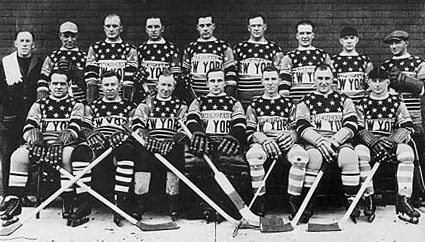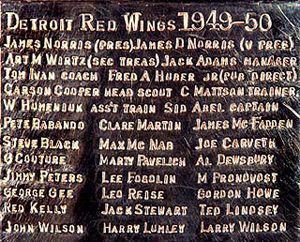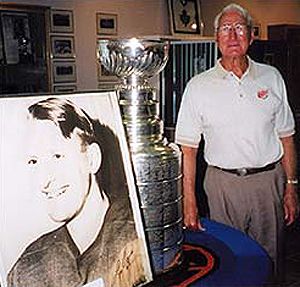Monday, June 7, 2010
1951-52 Detroit Red Wings Leo Reise, Jr. Jersey
Leo Reise, despite having vision in only one eye since his youth, played for the Hamilton Tigers, first in the Ontario Hockey League beginning in 1914, and then later in the NHL starting with the 1920-21 season. It was after this season that he became the father of Leo Reise, Jr. on this date in 1922. After two more seasons with the Tigers, he was then traded to the Saskatoon Crescents of the WCHL where he played for three seasons before returning to the NHL with the New York Americans for three and a half seasons prior to a half season with the New York Rangers. He then spent two seasons in the IHL with Pittsburgh before retiring. Reise, a defenseman, played eight seasons in the NHL, totaling 223 games, scoring 36 goals and 29 assists for 65 points.
1926-27 New York Americans - Leo Reise, Sr. back row, third from left
Leo Reise, Jr. followed in his father's footsteps, orginally playing junior hockey in Brantford and Guelph prior to joining the Navy and playing for teams in Victoria, Halifax and Winnipeg. With his Naval career now over, Reise, Jr. turned professional with the Chicago Black Hawks in 1945-46 for six games, and in doing so, became the first son of an NHL player to play in the NHL. He spent the majority of the season with Kansas City of the USHL and was named to the USHL First All-Star Team.
The following season he returned to the Black Hawks for 17 games prior to being traded to the Detroit Red Wings in December and getting into 31 games with Detroit where he would score his first NHL points with 4 goals and 6 assists while playing on a team with a rookie named Gordie Howe.
He became a regular in the Detroit lineup the following season and played 58 and then 59 games in 1947-48 and 1948-49, which included two consecutive trips to the Stanley Cup Finals.
Reise, Jr. had his best offensive season in 1949-50 with 21 points and Detroit once more returned to the finals, aided by Reise's overtime goals in both games 4 and 7 of the semifinals, to defeat the Rangers in double-overtime in the seventh and final game to make Leo Reise, Jr. a Stanley Cup champion.
The following year he would match his 21 point season high. In the 1951-52 season, the dominant Red Wings would cruise through the playoffs with sweeps of both Toronto and then Montreal to capture the second Stanley Cup of Reise's career.
After one more season with Detroit, his career then mirrored that of his father, as he was traded to the New York Rangers, which also turned out to be the final team of his NHL career, as he would play two seasons in Manhattan to close out his professional playing days.
In 2005, Reise was given a day with the Stanley Cup as part of a great program that allowed veteran players to participate in the now well known tradition which did not begin until 1995.
Today's featured jersey is a 1951-52 Detroit Red Wings Leo Reise, Jr. jersey. Note the unique treatment of the assistant captan's "A" which is contained in a diamond shape on the upper left chest. Captain's letters just don't get that kind of unique treatment anymore.
The classic Red Wings jersey was first introduced in 1932 when the club changed their name from the "Falcons" to the "Red Wings" and remains essentially unchanged to this day.
Check out this amazing video find, the Red Wings and Rangers prepare themselves for Game 2 of the 1950 Stanley Cup Finals, including footage of Leo Reise, Jr. talking to coach Tommy Ivan. Note the comment that the game is taking place at Toronto's Maple Leaf Gardens. This was due to Madison Square Garden in New York being occupied by a circus at the time!
Here is some more "intense sports drama", highlights of the deciding Game 7 of the 1950 finals, as the Stanley Cup is decided by a sudden-death goal in overtime. Check out the superlatives as the announcer recaps the drama of "the truly great international sport" of hockey.
Labels:
Detroit Red Wings,
Reise Leo Jr.
Subscribe to:
Post Comments (Atom)















I love the music of the first clip and the post production of the second one... how to capture the emotion of the winning goal when they probably had only one camera. Genius.
ReplyDeleteI'm surprised at how foolish the captain looks carting the Cup around on a wooden table. Hoisting it would be the natural thing but the old ways were more... respectful, maybe? I wonder what the players of that time think of the hoisting tradition.
We don't see any in this clip, but I'm sure everyone not on skates used to fall unceremoniously; the carpet is a great adition too.